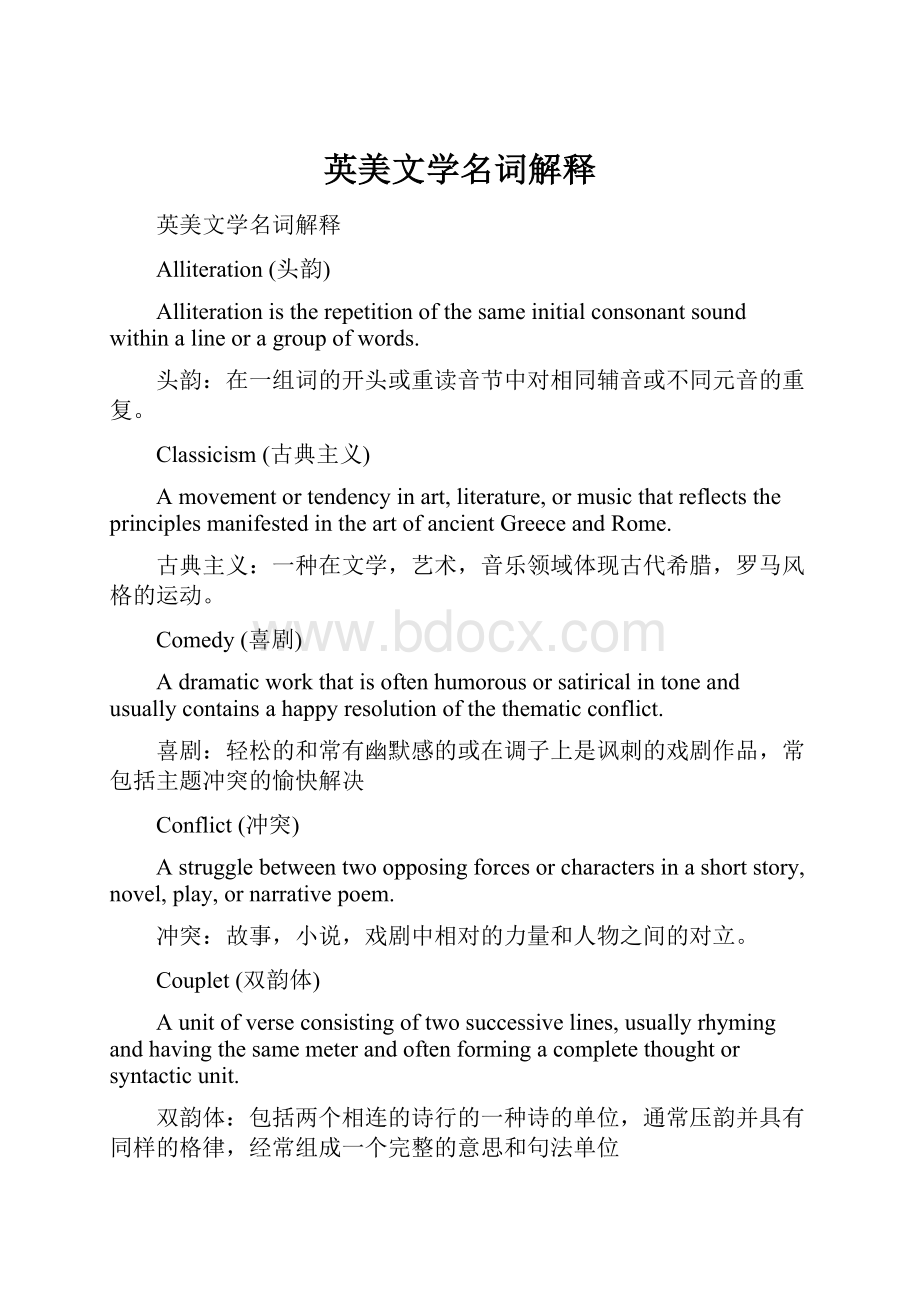英美文学名词解释.docx
《英美文学名词解释.docx》由会员分享,可在线阅读,更多相关《英美文学名词解释.docx(8页珍藏版)》请在冰豆网上搜索。

英美文学名词解释
英美文学名词解释
Alliteration(头韵)
Alliterationistherepetitionofthesameinitialconsonantsoundwithinalineoragroupofwords.
头韵:
在一组词的开头或重读音节中对相同辅音或不同元音的重复。
Classicism(古典主义)
Amovementortendencyinart,literature,ormusicthatreflectstheprinciplesmanifestedintheartofancientGreeceandRome.
古典主义:
一种在文学,艺术,音乐领域体现古代希腊,罗马风格的运动。
Comedy(喜剧)
Adramaticworkthatisoftenhumorousorsatiricalintoneandusuallycontainsahappyresolutionofthethematicconflict.
喜剧:
轻松的和常有幽默感的或在调子上是讽刺的戏剧作品,常包括主题冲突的愉快解决
Conflict(冲突)
Astrugglebetweentwoopposingforcesorcharactersinashortstory,novel,play,ornarrativepoem.
冲突:
故事,小说,戏剧中相对的力量和人物之间的对立。
Couplet(双韵体)
Aunitofverseconsistingoftwosuccessivelines,usuallyrhymingandhavingthesamemeterandoftenformingacompletethoughtorsyntacticunit.
双韵体:
包括两个相连的诗行的一种诗的单位,通常压韵并具有同样的格律,经常组成一个完整的意思和句法单位
Heroiccouplet(英雄双韵体)
Acoupletwritteniniambicpentameteriscalledaheroiccouplet.
英雄双韵体:
五步抑扬格的双韵体称英雄双韵体。
Essay(散文)
Ashortliterarycompositiononasinglesubject,usuallypresentingthepersonalviewoftheauthor.
散文:
内容通常论及一个主题的短小文章,通常表达作者个人的观点
FigureofSpeech
Awordoranexpressionthatisnotmeanttobeinterpretedinliteralsense.Themostcommonkindsoffiguresofspeech—simile,metaphor,personification,andmetonymy.
比喻:
不能直接按照字面意义理解的词语或表述方法。
常见的手法有明喻,暗喻,拟人,借喻。
Flashback(倒叙)
Aliterarydeviceinwhichanearliereventisinsertedintoanarrative.
倒叙,闪回镜头:
一种文学或电影的表现手法,往往在一段按正常时间顺序记叙的叙事中插入一件以前发生过的事情
Freeverse(自由诗体)
Versesthathasneitherametricalpatternoranregularpattern.
自由诗体:
既不具格式韵律又不具常规格律的诗体
Iambicpentameter(五步抑扬格)
Apoeticlineconsistingoffiveversefeet,witheachfootaniamb--thatis,anunstressedsyllablefollowedbyastressedsyllable.IambicpentameteristhemostcommonverselineinEnglishpoetry.
五步抑扬格:
一种诗句形式,每行诗句包含五个抑扬格音步。
五步抑扬格是英语诗歌最常见的诗行。
Imagery(意象)
Wordsorphrasesthatcreatepictures,orimages,inreaders‘mind.
意象:
用来在读者的思维中唤起某种图示或形象的词汇。
Lyric(抒情诗)
Apoem,usuallyashortone,thatexpressesaspeaker‘spersonalthoughtsorfeelings.
抒情诗:
一种用来抒发作者感情或思想的短诗。
Naturalism(自然主义)
Thepracticeofdescribingpreciselytheactualcircumstancesofhumanlifeinliterature,itistheextremeformofrealism.
自然主义:
在文学中精确地描述人类现实环境的实践,现实主义的最高表现形式。
Neoclassicism(新古典主义)
Arevivalinliteratureinthelate17thand18thcenturies,characterizedbyaregardfortheclassicalidealsofreason,form,andrestraintstyles.
新古典主义:
17、18世纪晚期的文学复兴,以尊重古代典型的推理形式和严谨文体为特征
Novel(小说)
Abooklengthfictionalprosenarrative,havingmanycharactersandoftenacomplexplot.
小说:
虚构的叙述性文章,有一定长度,较多的人物,和思想复杂的情节。
Pastoral(田园诗)
Akindofpoem,thatdealsinanidealizedwaywithshepherdsandrusticlife.
田园诗:
一种用理想的手法来体现牧羊人的乡村生活的诗歌。
Plot(情节)
Plotisthefirstandmostobviousqualityofastory.Itisthesequenceofeventsoractionsinashortstory,novel,play,ornarrativepoem.Forthereader,theplotistheunderlyingpatterninaworkoffiction,thestructuralelementthatgivesitunityandorder.Forthewriter,theplotistheguidingprincipleofselectionandarrangement.
Realism(现实主义)
Therepresentationinartorliteratureofobjects,actions,orsocialconditionsastheyactuallyare,withoutidealizationorpresentationinabstractform.
现实主义:
在艺术或文学中将事物,行为或社会状况按其起初情况进行的表现,而不用模糊的形式来表现或理想化
Rhyme(压韵)
Therepetitionofsoundsintwoormorewordsorphrasesthatappearclosetoeachotherinapoem.
压韵:
音在两个或两个以上的词汇或短语中的重复。
Rhythm(格律)
Thearrangementofstressedandunstressedsyllablesintoapattern.
重读音节和非重读音节的固定排列模式。
Romanticism(浪漫主义)
AnartisticandintellectualmovementoriginatinginEuropeinthelate18thcenturywhichemphasisontheindividual‘sexpressionofemotionandimagination,departurefromtheattitudesandformsofclassicism.
浪漫主义:
起源于18世纪末期欧洲的一种注重个人情感和想象力的表达的艺术和知识上的运动,它与古典主义的观点和形式相悖.
Sonnet(十四行诗)
A14-lineverseformusuallywritteniniambicpentameter.
十四行诗:
一种由十四行组成的诗歌形式,通常以五步抑扬格为押韵形式。
Streamofconsciousness(意识流)
Thestyleofwritingthatattemptstoimitatethenaturalflowofacharacter’sthoughts,feelingsreflections,andmentalimagesasthecharacterexperiencesthem.Itwasfirstusedin1922bytheIrishnovelistJamesJoyce.Thosenovelsbrokethroughtheboundsoftimeandspace,anddepictedvividlyandskillfullytheunconsciousactivityofthemindfastchangingandflowingincessantly(不间断地),particularlythehesitant,distracted(心烦意乱的)andillusory(虚假的)psychologypeoplehadwhentheyfacedreality.Ahighdegreeofemotioncanbeachievedbythistechnique.
意识流:
一种模仿作品中人物思想,思维,精神活动的自然过程的写作技巧。
Symbolism(象征主义)
Aliterarymovementinthelate19thcentury,characterizedbytheuseofsymbolstorepresentthings.
象征主义:
十九世纪的一种文学潮流,运用象征来体现事物。
Theme(主题)
Theme;Thegeneralideaorinsightaboutlifethatawriterwishestoexpressinaliterarywork.Alltheelementsofaliterarywork-plot,setting,characterization,andfigurativelanguage-contributetothedevelopmentofitstheme.
一篇文学作品中作家预期表达的关于生活的观点或见解。
作品中所有其他的元素——情节、背景、人物描写和比喻用语都是围绕主题展开的。
Tragedy(悲剧)
Ingeneral,aliteraryworkinwhichtheprotagonistmeetsanunhappyordisastrousend.
悲剧:
以主人公可悲的或灾难性的结局结束的故事。
Character:
Inappreciatingashortstory,charactersareanindispensableelement.Charactersarethepersonspresentedinadramaticornarrativework.Forstdividescharactersintotwotypes:
flatcharacter,whichispresentedwithoutmuchindividualizingdetail;androundcharacter,whichiscomplexintemperamentandmotivationandisrepresentedwithsubtleparticularity.
Climax:
Thepointofgreatestintensity,interest,orsuspenseinagogotory’sturningpoint.Theactionleadingtotheclimaxandthesimultaneousincreaseoftensionintheplotareknownastherisingaction.Allactionaftertheclimaxisreferredtoasthefallingaction,orresolution.Thetermcrisisissometimesusedinterchangeablywithclimax.
Denouement结局:
Theoutcomeofaplot.Thedenouementisthatpartofaplay,shortstory,novel,ornarrativepoeminwhichconflictsareresolvedorunraveled,andmysteriesandsecretsconnectedwiththeplotareexplained.
Epic:
Alongnarrativepoemtellingaboutthedeedsofagreatheroandreflectingthevaluesofthesocietyfromwhichitoriginated.Manyepicsweredrawnfromanoraltraditionandweretransmittedbysongandrecitationbeforetheywerewrittendown.
Pointofview:
Thevantagepointfromwhichanarrativeistold.Therearetwobasicpointsofview:
first-personandthird-person.Inthefirst-personpointofview,thestoryistoldbyoneofthecharactersinhisorherownwords.Thefirst-personpointofviewislimited.Inthethird-personpointofview,thenarratorisnotacharacterinthestory.Thenarratormaybeanomniscient.Ontheotherhand,thethird-personnarratormighttellastoryfromthepointofviewofonlyonecharacterinthestory.
Style:
Anauthor’scharacteristicwayofwriting,determinedbythechoiceofwords,thearrangementofwordsinsentences,andtherelationshipofthesentencestooneanother.
Symbol:
Asymbolisasignwhichsuggestsmorethanitsliteralmeaning.Inotherwords,asymbolisbothliteralandfigurative.Asymbolisawayoftellingastoryandawayofconveyingmeaning.Thebestsymbolsarethosethatarebelievableinthelivesofthecharactersandalsoconvincingastheyconveyameaningbeyondtheliterallevelofthestory.
LostGeneration:
Thistermhasbeenusedagainandagaintodescribethepeopleofthepostwaryears.ItdescribesthewriterslikeHemingwaywholivedinpoverty.ItdescribestheAmericanswhoreturnedtotheirnativelandwithanintenseawarenessoflivinginanunfamiliarchangingworld.TheyoungEnglishandAmericanexpatriates,menandwomen,werecaughtinthewarandcutofffromtheoldvaluesandyetunabletocometotermswiththenewerawhencivilizationhadgonemad.Theywanderedpointlesslyandrestlessly,enjoyingthingslikefishing,swimming,bullfightandbeautiesofnature,buttheywereawareallthewhilethattheworldiscrazyandmeaninglessandfutile.Theirwholelifeisundercutanddefeated.
迷惘的一代:
这个词往往被反复用来指战后的人们。
它用来描述像海明威那样生活在贫困中的作家,描写返回祖国后意识到他们生活在一个陌生的急剧变化的世界里的人们。
那些移居国外的那些年轻的美国人和英国人,不论男女,经历的战争的洗礼,他们和旧的价值观完全的隔离然而又无法融入这个社会文明疯狂发展的新世界。
他们漫无目的不停地游荡,他们喜欢钓鱼、游泳、斗牛和大自然的美景,但他们自始至终都觉得这是一个疯狂、毫无意义、颓废的时代。
他们整个的生活都是颓废失败的。
Protagonist:
Thecentralcharacterofadrama,novel,shortstory,ornarrativepoem.Theprotagonististhecharacteronwhomtheactioncentersandwithwhomthereadersympathizesmost.Usuallytheprotagoniststrivesagainstanopposingforce,orantagonist,toaccomplishsomething.
主人公:
戏剧、长篇小说、短篇小说或叙事诗的中心人物。
主人公是所有行动所围绕的中心,也是读者最为关心和同情的人物。
主人公通常在故事中与反面人物作斗争以得到某个东西。
Suspense:
Thequalityofastory,novel,ordramathatmakesthereaderoraudienceuncertainortenseabouttheoutcomeofevents.
悬念:
故事、小说或戏剧使得读者或观众对事件的结果所感到的不确定或紧张感。
Setting:
Thetimeandplaceinwhichtheeventsinashortstory,novel,playornarrativepoemoccur.Settingcangiveusinformation,vitaltoplotandtheme.Often,settingandcharacterwillrevealeachother.
背景:
在短篇、长篇小说、或叙事诗里面故事发生的时间和地点,它和人物通常会相互揭示。
背景可以得读者提供对于情节和主题至关重要的信息。
Pun:
Theuseofawordorphrasetosuggesttowormoremeaningatthesametime.Punsaregenerallyhumorous.
双关:
使用一个词来同时指代两个或以上意义的一种幽默的方法,
Metaphysicalpoetry:
ThepoetryofJohnDonneandother17thcenturypoetswhowroteinasimilarstyle.Metaphysicalpoetryischaracterizedbyverbalwitandexcess,ingeniousstructure,irregularmeter,colloquiallanguage,elaborateimagery,andadrawingtogetherofdissimilarideas.
玄学诗:
约翰•多恩的诗或17世纪其他诗人写的相同风格的诗。
玄学诗多使用巧智,结构精巧,韵律多变,语言口语化,意象奇特,把不同的事物进行并置。